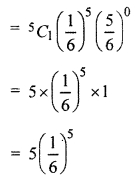Rajasthan Board RBSE Class 11 Maths Chapter 14 Probability Miscellaneous Exercise
Question 1.
In throwing a coin n times, n(S) is –
(A) 2n
(B) 2n
(C) n2
(D) n/2
Solution:
Thus (B) is correct.
Question 2.
In throwing two dice and sample space of getting sum 3 is –
(A) (1, 2)
(B) {(2, 1)}
(C) {(3, 3)}
(D) {(1, 2), (2, 1)}
Solution:
Thus (D) is correct.
Question 3.
If tossing a coin and a dice simultaneously the number of elements in sample space is—
(A) 12
(B) 6
(C) 64
(D) 36
Solution:
No. of elements = n{H, T} × n{1, 2,3,4,5,6}
= 2 × 6 = 12
Thus, (A) is correct.
Question 4.
Result of each experiment is called –
(A) Sample space
(B) Random test
(C) Sample point
(D) Ordered pair
Solution:
Thus, (C) is correct.
Question 5.
If three coin are tossed and E be the event to getting at least one head, then n(E) will be –
(A) 6
(B) 3
(C) 4
(D) 8
Solution:
S = {HHH, HHT, HTH, HTT, THH, THT, TTH, ITT)
n(E) = 4
Thus, (C) is correct.
Question 6.
if E1 ∩ E2 = Φ, then E1 and E2 will be –
(A) Exclusive
(B) Independent
(C) Dependent
(D) Complementary
Solution:
Thus, (D) is correct.
Question 7.
Favourate events of 53 Mondays in leap year will be –
(A) 7
(B) 2
(C) 1
(D) 14
Solution:
Total days in a leap year = 366
Remaining day of after 53 weeks
= \(\frac { 366 }{ 53 } \) = 2 remaining
Thus, (B) is correct.
Question 8.
Three are 4 white 5 black and 2 red balls in an urn. Favourable cases of three different colour balls will be –
(A) 9
(B) 24
(C) 12
(D) 7
Solution:
White balls = 4, Black balls = 3
and Red balls = 2
Favourable cases of three different colour balls
= 4 × 3 × 2 = 24
Thus, (B) is correct.
Question 9.
In two mutually exclusive events value of P (A ∪ B) is –
(A) P(A) + P(B)
(B) P(A) + P(B) – P(A ∩ B)
(C) P(A).P(B)
(D) P(A).P(B/A)
Solution:
Thus, (A) is correct.
Question 10.
The probability of solving the question by three students A,B and C are 1/2, 1/3 and 1/4, then probability of solving the question by at least one is –
(A) 1/24
(B) 1/4
(C) 3/4
(D) 1/9
Solution:
P(A)= 1/2, P(B) = 1/3, P(C) = 1/4
Required probability
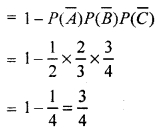
Thus, option (C) is correct.
Question 11.
On tossing two dices simultaneously, probability to getting diference of numbers appear as 1 will be –
(A) 5/18
(B) 1/4
(C) 2/9
(D) 7/36
Solution:
Total events = 6 × 6 = 36 ⇒ n(S) = 36
Favourable events
A = {(1, 2), (3, 4), (4, 5), (5, 6), (2, 3), (6, 5), (5, 4), (4, 3), (3, 2), (2, 1)}
n(A) = 10
Thus, Required probability

Thus, (A) is correct.
Question 12.
A card is drawn from a deck of cards, probability of getting red or black card is –
(A) 1/4
(B) 1/2
(C) 3/4
(D) 26/51
Solution:
Required probability

Thus, (B) is correct.
Question 13.
On throwing two dices probability to getting sum of numbers appear as multiple of 4 will be –
(A) 1/4
(B) 1/3
(C) 1/9
(D) 5/9
Solution:
Multiples of 4 are = 4, 8, 12, 16,20,24, 28, 32, 36, 40, … etc.
Thus favourable events A = {(1, 3), (3, 1), (4,4), (5, 3), (3,5), (6, 2), (6,6)}
n(A) = 9 and n(S) = 36
Thus, required probability

Thus, (A) is correct.
Question 14.
If 5 digit numbers are formed by using digit 1,2,3,4, 5,6 and 8, then probability to get even digit at both end will be –
(A) 5/7
(B) 4/7
(C) 3/7
(D) 2/7
Solution:
No. of total digits = 7
Even number appear on both end so, favourable cases = 2
Thus, required probability = \(\frac { 2 }{ 7 } \)
Thus, (D) is correct.
Question 15.
In throwing three dices probability to get same digit on all three is –
(A) 1/36
(B) 3/22
(C) 1/6
(D) 1/18
Solution:
∵ A = {(1, 1, 1), (2, 2, 2), (3, 3, 3), (4, 4, 4), (5, 5, 5), (6, 6, 6)}
n(A) = 6, n(S) = 63 = 216
Required probability

Thus, (A) is correct.
Question 16.
In a swimming race odds in favour of A is 2 : 3 and odds in opposite of B is 4 : 1. Find the probability of winning of A orB is –
(A) 1/5
(B) 2/5
(C) 3/5
(D) 4/5
Solution:
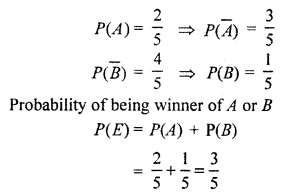
Question 17.
10 students are sitting in a raw randomly, probability that two specific students do not sit closely is –
(A) 1/5
(B) 2/5
(C) 3/5
(D) 4/5
Solution:
Required probability

Thus, (D) is correct.
Question 18.
There are 12 sections in a group, in which four sections are faulty 3 sections are randomly drawn one by one. Without replacement probability to get no. one as faulty is –
(A) 3/55
(B) 13/55
(C) 14/55
(D) 17/55
Solution :
Total terms = 12, Non-facility sections = 12 -4 = 8
Faulty section = 4
Probability to get no. one as fault in three attempt is –
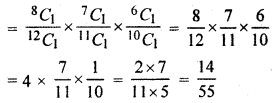
Thus (C) is correct.
Question 19.
Probability of any sure event will be –
(A) 0
(B) 1/2
(C) 1
(D) 2
Solution:
Thus (C) is correct.
Question 20.
A family having 3 children in which at least one boy, then probability that family have one boy and one girl is –
(A) 1/2
(B) 1/3
(C) 1/4
(D) 3/4
Solution:
Sample space of children in a family is :
S = {B, G, G, B, B, G, B, B, G}
Event of 2 boys and 1 girl A = {B, B, G}
∴ n(S) = 3, n(A) = 1
Thus, required probability = \(\frac { n(A) }{ n(S) } \) = \(\frac { 1 }{ 3 } \)
Thus, (B) is correct.
Question 21.
The probability of taking examination in class by a teacher is 1/5. If a student is absent two times then probability that he was absent at least in one examination is –
(A) 9/25
(B) 11/25
(C) 13/25
(D) 23/25
Solution:
Let student is absent in first examination, event is collect E and absent in 2nd is F, then
According to question
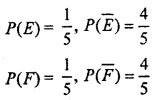
Probability that students is absent in at least one exam. =
1 – (Prob. that student is absent in both the exams)

Thus, this is prob. that student appear at least one examination.
Thus, (A) is correct.
Question 22.
In a non-leap year. Find the probability to getting 53 Mondays.
Solution:
There are 52 Sundays in a leap year and 2 days are remains. If one of them is Sunday, then there will be 53 Sundays.
Now, probability that at least two days one of them is Sunday = \(\frac { 1 }{ 7 } \)
∴ Required probability = \(\frac { 1 }{ 7 } \)
Question 23.
A and B are two mutually exclusive events and P(A) – 0.3, P(B) = K and P(A ∪B) = 0.5, then find the value of K –
Solution:
P(A ∪ B) = P(A) + P(B)
⇒ P{B) = P(A ∪ B) – P(A)
⇒ P(B) = K = 0.5 – 0.3
= 0.2
Thus K = 0.2.
Question 24.
Words are formed by using letters of word ‘PEACE’. Find the probability that word contains both E.
Solution:
Total words formed by letters of word ‘PEACE’
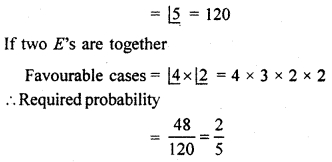
Question 25.
There are 6 red and 8 black balls in a bag. 4 balls are taken out two times, 4 balls taken once are replaced back. What will be the probability that 4 balls in first attempt be red and in second attempt be black ?
Solution:
Total balls = 6 + 8 = 14
Since ball are replaced
∴ Probability to draw 4 red ball in 1st chance and 4 black balls in 2nd chance.
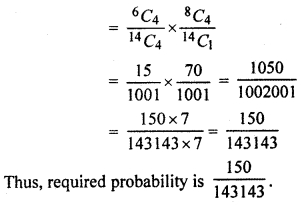
Question 26.
A man speaks truth 3 times out of 5. He says that in tossing 6 coins,two tails appear so what is the probability that this event is actually true ?
Solution:
Let E represents the statement of a person. Now, S1 is the event of getting 2 heads and S2 is the event of not getting 2 heads on tossing 6 coins
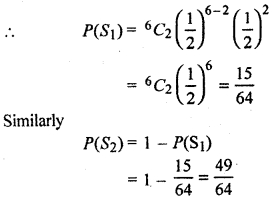
Now, Probability of statement to be truth if 2 heads are obtained on tossing of 6 coins

∵ Person speaks truth 3 times out of 5.
Similarly, Probability of statement to be not truth if 2 heads are obtained on tossing of 6 coins
Now, the probability that this event is actually true,
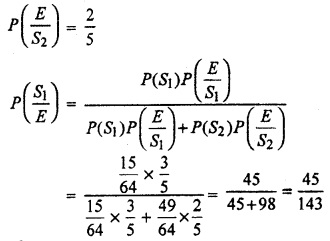
Question 27.
In throwing two dices, what is the probability that neither same digit appear nor sum of digit be 9 ?
Solution:
Total events in throwing two dices simultaneously
n(S) = 62 = 36
Total events to get same digit at two dices and sum 9
A = {(1, 1), (2, 2), (3, 3), (4, 4), (5, 5), (6, 6), (3, 6), (4, 5), (5, 4), (6, 3)}
n(A) = 10
Probability to get same digit on dices or sum 9

Thus, required probability

Question 28.
Three coins are tossed simultaneously, then find the probability where as –
(i) Exactly two heads appear.
(ii) At least two heads appear,
(iii) Maximum two head appear.
(iv) AH the three are heads.
Solution:
In throwing three coins obtained sample space
S = {(HHH), (HHT), (7/77/7), (HTT), (THH), (THT), (TTH), (TTT)}
n(s) = 8
(i) Probability to get exactly two heads = \(\frac { 3 }{ 8 } \)
(ii) Events if at least two heads apear
A = {(HHH), (HHT), (HTH), (THH)}
∴ n(A) = 4
Thus, required probability

(iii) Event to get maximum 2 heads –
A = {(HHT), (HTH), (HTT), (THH), (THT), (TTH), (TTT)}
n(A) = 7
Thus, required probability

(iv) Events to get all the three heads
A = {HHH}
n(A) = 1
Thus, required probability

Question 29.
In a horse race, four horses A, B, C, D run odds in favour of A, B, C, D are respective of 1 : 3, 1 : 4, 1: 5 and 1: 6. Find the probability that are one of them wins.
Solution:
Let event to win horses A, B, C, D are E, F, G, H respectively.

Since only one is the winner
Thus, these are mutually exclusive events
∴ Required probability
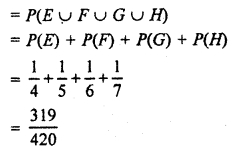
Question 30.
Probability that a person will alive in next 25 years is 3/5 and of his wife 2/3. Find the following probability:
(i) Both remains alive.
(ii) None of two remains alive.
(iii) At least one remains alive.
(iv) Only wife remains alive.
Solution:
According to question, prob. of one person alive
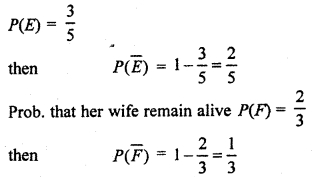
(i) Prob. that both remains alive
By formula P(AB) = P(A).P(B)
P(EF) = P(E).P(F)
= \(\frac { 3 }{ 5 } \) × \(\frac { 2 }{ 3 } \) = \(\frac { 2 }{ 5 } \)
(ii) Probability that none of them remain alive
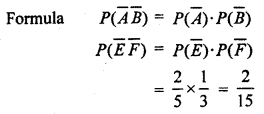
(iii) Probability that at least one remain alive
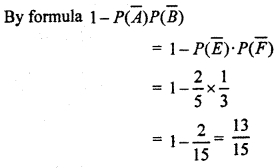
(iv) Prob. that only wife remain alive
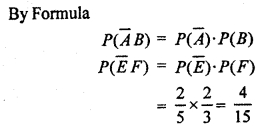
Question 31.
A and B are independent witness. Probability that A speaks truth is x and y of B if A agree with B for any statement, then prove that probability of the truth of statement will be xy/(1 – x + 2xy).
Solution:
5 The prob. that A speaks truth
P(A) = x
Probability that B speaks truth
P(B) = y
If both are agree with any statement then, prob. that statement is true

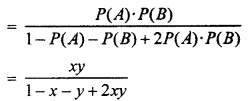
Question 32.
Three males A,B C tossed a coin one by one. Who gets tail first he will win. If A has first chance, then what is the probability to winning of A.
Solution:
Prob. to get tail = \(\frac { 1 }{ 2 } \)
and Pro. to not get tail = \(\frac { 1 }{ 2 } \)
∵ A toss a coin in first chance thus he may win 1st time, 4th time, 7th time.
∴ Prob. that A win
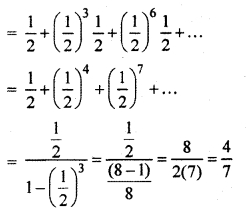
Similarly prob. that B wins
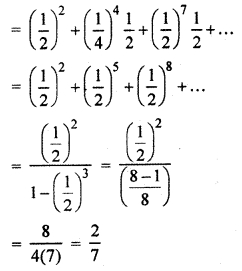
Similarly prob. that C wins
![]()
Question 33.
Sulakshina and Sunayana tossed a coin one by one. Who get tail first she will win.If Sulakshina has first chance, then find probability that both of them win.
Solution:
Prob. to get.tail = \(\frac { 1 }{ 2 } \)
and prob. to not get tail = \(\frac { 1 }{ 2 } \)
∵ Since first, sulakshina toss a coin
Thus, she may win in 1st, 3rd, 5th attempt
∴ Probability that Sulakshina wins
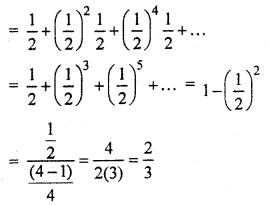
and probability that sunayana wins
![]()
Question 34.
One digit is selected from the following two groups of numbers –
(1, 2, 3, 4, 5, 6, 7, 8, 9), (1, 2, 3, 4, 5, 6, 7, 8, 9)
If P1 is sum of both digit as 10, P2 is sum of both digit as 8, then find P1 + P2.
Solution:
P1 = {(1, 9), (2, 8), (3, 7), (4, 6), (5, 5), (6, 4), (7, 3), (8, 2), (9, 1)}
n(P1) = 9
Total ways = 9 × 9 = 81 = n(S)
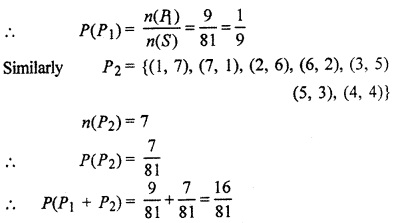
Question 35.
If P(A) = 0.4, P(B) = 0.8, P(B/A) = 0.6, then find P(A/B) and P(A ∪ B).
Solution:
By formula
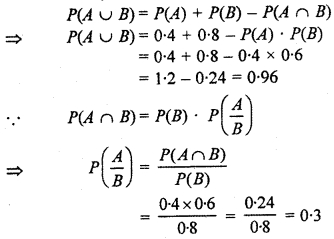
Question 36.
If P(E) = 0.35, P(P) = 0.45, P(E ∪F) = 0.65, then find P(F/E).
Solution:
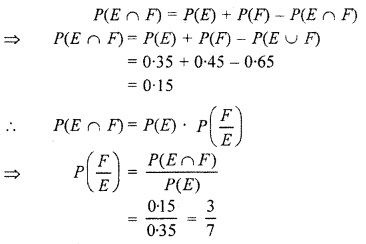
Question 37.
A dice is thrown five times, find the probability getting only one.
Solution:
Probability to get 1 in throwing a dice = (\(\frac { 1 }{ 6 } \))
and Probability not get = 1 – \(\frac { 1 }{ 6 } \) = \(\frac { 5 }{ 6 } \)
Thus probability to get only digit 1 in five tosses
